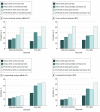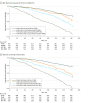Association of Frailty and Malnutrition With Long-term Functional and Mortality Outcomes Among Community-Dwelling Older Adults: Results From the Singapore Longitudinal Aging Study 1
- PMID: 30646023
- PMCID: PMC6324309
- DOI: 10.1001/jamanetworkopen.2018.0650
Association of Frailty and Malnutrition With Long-term Functional and Mortality Outcomes Among Community-Dwelling Older Adults: Results From the Singapore Longitudinal Aging Study 1
Abstract
Importance: Physical frailty and malnutrition are prevalent among older adults and may be associated with functional and mortality outcomes.
Objective: To assess the health outcomes associated with physical frailty and malnutrition singly and in combination among older adults.
Design, setting, and participants: Population-based cohort study (Singapore Longitudinal Aging Study 1). Included were 2804 community-dwelling adults in Singapore aged 55 years or older at baseline (September 1, 2003, to December 23, 2005), with 2 follow-ups at 2- to 3-year intervals (from March 7, 2005, to September 10, 2007, and from November 13, 2007, to December 12, 2009) and a 12-year mortality follow-up to March 31, 2017. Data analysis was from July 1 to September 28, 2017.
Main outcomes and measures: Baseline physical frailty (Fried criteria) with participants categorized according to the total score as frail (3-5 points), prefrail (1-2 points), or robust (0 point), and nutritional status (Nutrition Screening Initiative DETERMINE Your Nutritional Health Checklist and Mini Nutritional Assessment Short-Form [MNA-SF]). Baseline (prevalent) and follow-up (incident) instrumental/basic activities of daily living (IADL/ADL) disability, poor quality of life (QOL), and mortality were measured. Estimates of association were by odds ratios (ORs) and hazard ratios (HRs) and their 95% CIs.
Results: The participants (mean [SD] age, 66.0 [7.7] years; 1033 [36.8%] male; 2611 [93.1%] Chinese) included 1021 (37.6%) categorized as robust with MNA-SF normal nutrition (R-NN), 330 (12.2%) robust with MNA-SF at risk/malnourished (R-ARM), 734 (27.0%) prefrail/frail with MNA-SF normal nutrition (PFF-NN), and 631 (23.2%) prefrail/frail with MNA-SF at risk/malnourished (PFF-ARM). Among these 2804 participants, 44 had missing frailty status, and 78 had missing MNA-SF nutritional status; therefore, 88 participants in total had missing frailty-nutritional status. In cross-sectional analyses, the prevalence of IADL/ADL disability was lowest among the R-NN group (169 [16.9%]) and increased substantially only among the PFF-ARM group (249 [40.2%]) (OR, 1.88; 95% CI, 1.40-2.53). Poor QOL prevalence was lowest among the R-NN group (142 [14.1%]), and the increase in other frailty and nutritional status groups was highest in the PFF-ARM group (255 [41.3%]) (OR, 2.61; 95% CI, 1.96-3.49). In longitudinal analyses, significant association with only incident poor QOL across frailty and nutritional status groups was highest in the PFF-ARM group (89 [34.8%]) compared with the R-NN group (132 [19.2%]) (OR, 1.70; 95% CI, 1.17-2.48). The mortality rate was lowest in the R-NN group (0.54 per 100 person-years) and highest in the PFF-ARM group (3.04 per 100 person-years) (HR, 1.72; 95% CI, 1.01-2.92). The results based on the Nutrition Screening Initiative measure of nutritional status were similar.
Conclusions and relevance: Reported adverse health outcomes attributed to poor nutrition often appear more likely to be associated with physical frailty. Prefrail/frail older persons with poor nutrition might be targeted for interventions to prevent or delay adverse functional and mortality outcomes.
Conflict of interest statement
Figures


References
-
- Pauly L, Stehle P, Volkert D. Nutritional situation of elderly nursing home residents. Z Gerontol Geriatr. 2007;40(1):-. - PubMed
-
- Pettigrew RA. Identification and assessment of the malnourished patient. Baillieres Clin Gastroenterol. 1988;2(4):729-749. - PubMed
-
- Mühlethaler R, Stuck AE, Minder CE, Frey BM. The prognostic significance of protein-energy malnutrition in geriatric patients. Age Ageing. 1995;24(3):193-197. - PubMed
-
- Sharkey JR. The interrelationship of nutritional risk factors, indicators of nutritional risk, and severity of disability among home-delivered meal participants. Gerontologist. 2002;42(3):373-380. - PubMed
Publication types
MeSH terms
LinkOut - more resources
Full Text Sources
Medical

